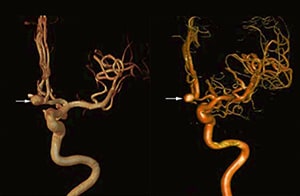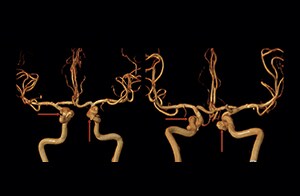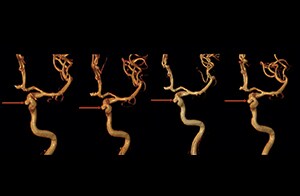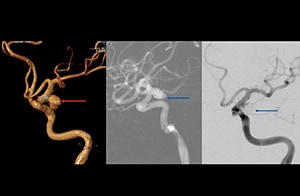FieldStrength MRI magazine
User experience - October 2016
3.0T MRA without contrast agent demonstrates high performance in cerebral aneurysm imaging
The Sixth Affiliated People’s Hospital, Shanghai Jiao Tong University (China), uses timeof-flight MR angiography (TOF MRA) to visualize cerebral aneurysms. The team has high confidence in their 3D TOF MRA method when imaging patients with small aneurysms.

Yuehua Li, MD, PhD, Professor of Radiology at The Sixth Affiliated People’s Hospital, Shanghai Jiao Tong University, China.
"3D TOF is easy to use and background signal suppression is very good. We use SENSE to shorten the scan duration"
Visualizing small aneurysms
“Our team highly appreciates the capabilities of MRI for noninvasive visualization of aneurysms smaller than 5 mm. Both MR and CT can be used to image aneurysms, but MR angiography can be performed without contrast agent, and without ionizing radiation it is not influenced by skull bones.”
“Visualization of small cerebral aneurysms is relevant because detection of unruptured aneurysms can influence patient care,” notes Yuehua Li, MD, PhD, professor of the radiology department. “After follow-up examinations, patients with high-risk aneurysms can receive therapeutic interventions to decrease the risk of rupture.”
High resolution and high SNR are essential
“The 3D TOF MR angiograms are obtained by using 3D T1- weighted FFE sequences (TR 35 ms, TE 7 ms, flip angle 20 degrees, field of view 250 × 190 × 108 mm, matrix 732 × 1024, four slabs, 180 slices of 0.8 mm thickness, acquisition time 8:56 minutes). On our Achieva 3.0T MRI system with an 8-channel head coil, 3D TOF is easy to use and the background signal suppression is very good. Maximum intensity projections (MIPs) and volume-rendered images are reconstructed from the data. We use a single-artery highlighting method to reduce arterial overlay. The method can also be used for carotids or other small intracranial vessels.”
Dr. Li uses a protocol based on 3D time-of-flight (TOF) MRA. “High resolution and high SNR are the most important factors when visualizing small aneurysms. In order to achieve that, scan duration is the trade-off,” Dr. Li says. “To shorten the scan duration we use SENSE.”
“We recommend that 3D TOF MRA would be an additional approach for patients with small cerebral aneurysms, due to its non-invasive nature and high degree of accuracy and sensitivity” [2]
Study shows high accuracy
“Advances in MR imaging, the high SNR and spatial resolution of 3.0T, increasing observer experience and improved postprocessing techniques have improved the capabilities of MRA over the last decade. We found that 3D TOF MRA provides excellent images for the visualization of small cerebral aneurysms which enables us to accurately diagnose, and this accuracy appears to be similar to that obtained with DSA according to data from a 2014 study," [2] Dr. Li says. “Aneurysm location can influence how easy it is recognized. Infundibula can mimic aneurysms, adding to the difficulty of interpretation. On MIP images, small aneurysms can also be easily misinterpreted when the aneurysm overlaps with the vessel. This is why in our method we are viewing the images from multiple angles.” “In the hundreds of patients with aneurysms that we scanned, we saw no significant differences in accuracy, sensitivity or specificity among the locations. [2] We think this is the result of technical advances in image acquisition and postprocessing algorithms.”
3D TOF MRA chosen for prevalence study
According to Dr. Li, the good performance of MRA makes it a candidate to replace DSA. “We recommend that 3D TOF MR angiography would be an additional approach for patients with small cerebral aneurysms. This is due to its non invasive nature, ease of use and high degree of accuracy and sensitivity,” he concludes.
“Our high confidence in the 3D TOF MRA method was the reason to select this method for a study on the prevalence of unruptured cerebral aneurysms in Chinese adults, which involved finding the location and size of unruptured cerebral aneurysms. By the way, that study found a prevalence of 7% and most lesions had a diameter of less than 5 mm," [3] says Dr. Li.
References
1. Li MH, Cheng YS, Li YD, Fang C, Chen SW, Wang W, Hu DJ, Xu HW. Large- cohort comparison between three-dimensional time-of-flight magnetic resonance and rotational digital subtraction angiographies in intracranial aneurysm detection. Stroke. 2009;40:3127-9.
2. Li Y, et al. Accurate diagnosis of small cerebral aneurysms ≤5 mm in diameter with 3.0-T MR angiography. Radiology. 2014;271:553-60. 3. Li Y, et al. Prevalence of unruptured cerebral aneurysms in Chinese adults aged 35 to 75 years: A cross-sectional study. Ann Intern Med. 2013;159(8):514-521.
Results from case studies are not predictive of results in other cases. Results in other cases may vary. Results from this facility are not predictive of results in other facilities. Results in other facilities may vary.
Clinical cases

Related information
More from FieldStrength




